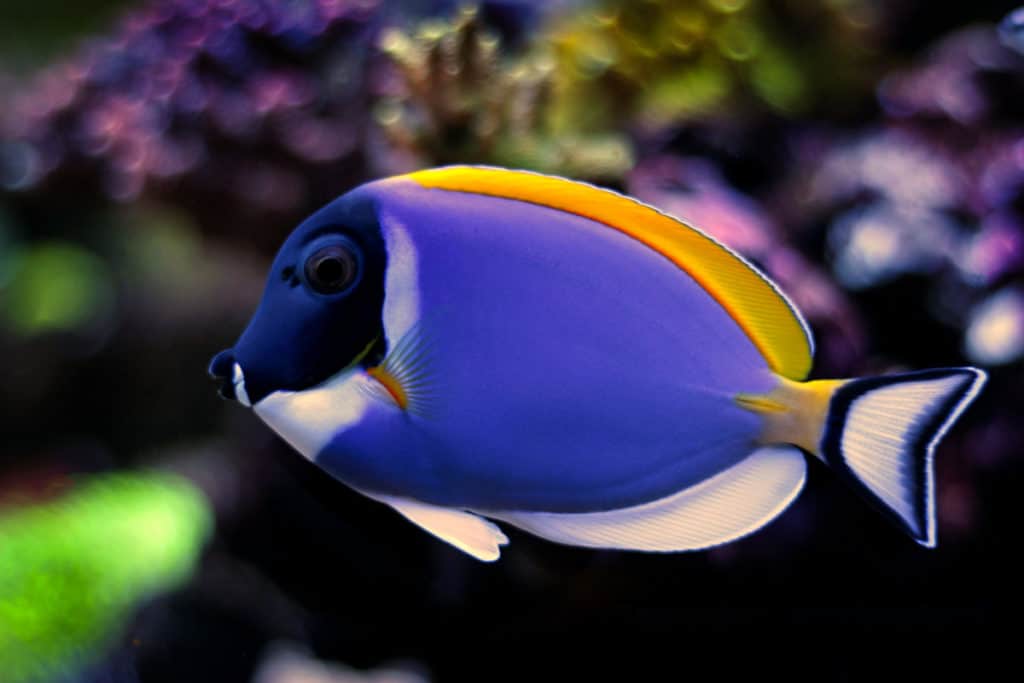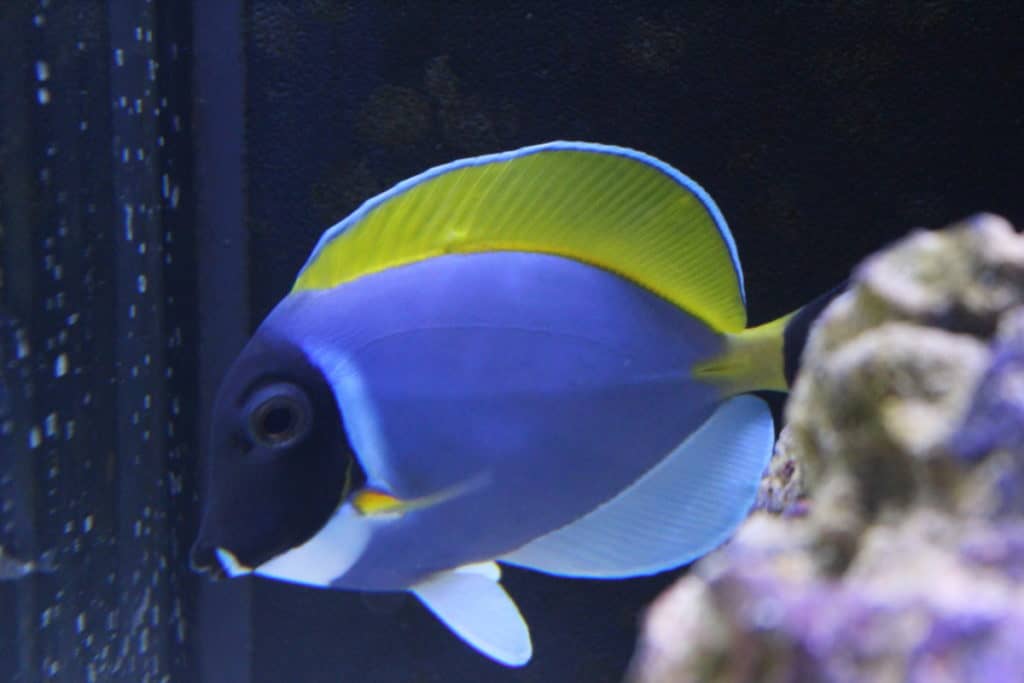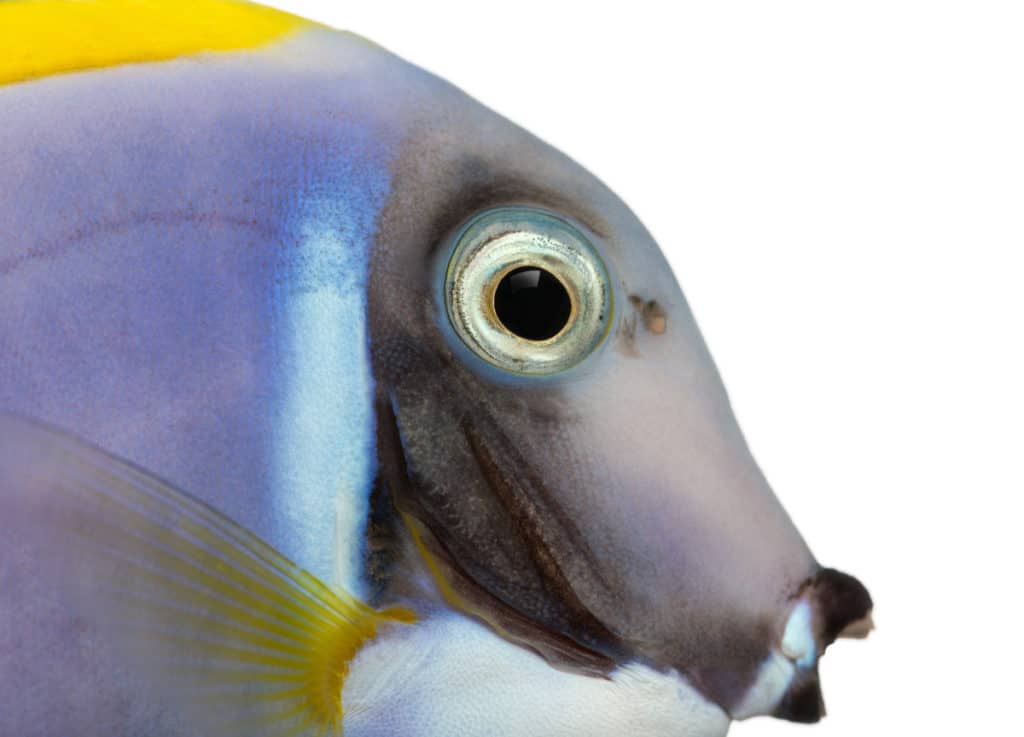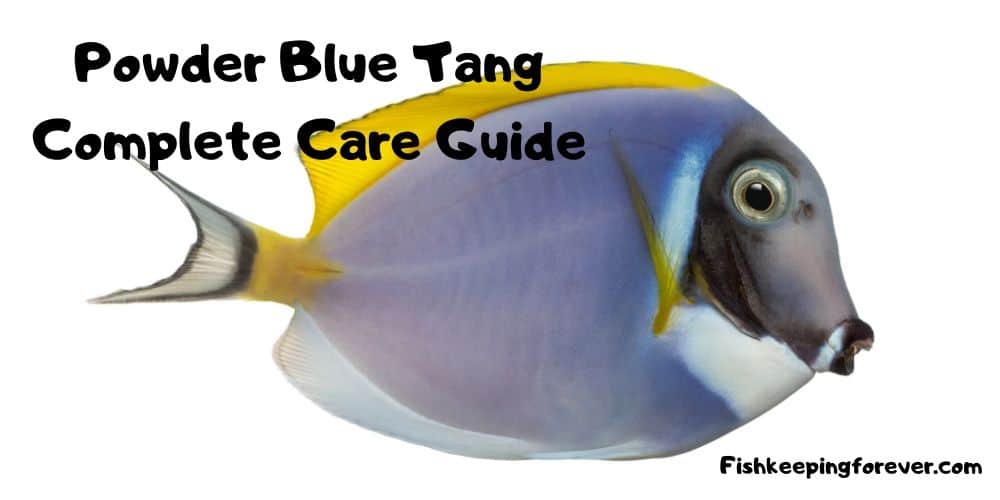There are many ways of injecting personality into your tank’s community, but the introduction of a Powder Blue Tang is certainly not for the faint-hearted.
These characterful fish with highly recognizable blue coloration, yellow dorsal fin, and razor-sharp spine, will rapidly want to establish themselves as the boss, so introducing them into your marine aquarium should be a well-considered decision.
Powder Blue Tangs are reputed for being high maintenance and will need to have attention paid to their conditions and feeding to thrive.

When cared for successfully, the inclusion of a Powder Blue Tang is a satisfying pastime and it certainly makes a beautiful and long-lived addition to any tropical tank.
In this comprehensive guide, we provide a thorough overview of all you need to know to make a Powder Blue Tang a thriving resident in your aquarium.
Table of Contents
Species Profile
| Common Names | Blue Tang, Powder Blue Surgeon fish, PBT, Atlantic Blue Surgeon fish, Pale Blue Tang |
|---|---|
| Scientific Name | Acanthurus leucosternon |
| Family | Acanthuridae |
| Care level | Moderate |
| Temperament | semi-aggressive |
| Size | 9-10 Inches |
| Diet | Herbivore |
| Reef Safe | Yes |
| Water Conditions | 74-80° F, dKH 8-12, pH 8.1-8.5, sg 1.020-1.024 |
| Tank Size | 100-125 Gals minimu |
| Lifespan | 5-10 Years |

Origins and Natural Habitat of the Powder Blue Tang
The Powder Blue Tang is part of the Acanthuridae family, whose name is derived from the Greek ‘akantha’, meaning thorn and ‘oura’, which means tail.
This refers to the common distinctive feature of a scalpel-sharp bladed tail, formed from modified scales, which is common to the surgeonfishes, tangs, and unicornfishes that make up this group.
The Latin name for the Powder Blue Tang is Acanthurus Leucosternon.
Alternative Names for the Powder Blue Tang include:
- Powder Blue Surgeonfish
- Atlantic Blue Surgeonfish
- Atlantic Blue Tang
- Blue Tang
- Pale Blue Tang
- Atlantic Yellow Tang
- Powder Blue
- PBT
Powder Blue Tangs may be mistaken for Regal Blue Tangs (Paracanthurus hepatus), another type of surgeonfish, as well as other related species that also carry the moniker of ‘blue tang’.
In its natural environment, the Powder Blue Tang makes its home among the rocky, sandy and coral outcrops of reefs in the tropical waters of the Indian Ocean.
This Tang is reef safe: Learn more about this in the article Is powder blue tang reef safe?
Its expansive distribution means it can be found anywhere between East Africa and Indonesia.
Warm, well-oxygenated and light-filled waters of around 20 degrees Celsius (68 degrees Fahrenheit) provide the ideal environment for supporting the incredibly biodiverse flat top reefs and seaward slopes where disparate shoals of these fish forage, covering several miles per day with ease.
Key Physical Characteristics of the Powder Blue Tang
Shape & Appearance
Acanthurus Leucosternon is a ray-finned, oval-shaped, bony fish with lateral compression that gives it a narrow, stern profile. It swims with its pectoral fins and has a crescent-shaped caudal fin.
Size
In the aquarium, Powder Blue Tangs are expected to achieve a maximum length of 9 to 10 inches (22 to 25 centimeters).
Sting in the tail
A key characteristic of the Powder Blue Surgeonfish is its scalpel-sharp, bladed spine at the base of its tail. This spine is capable of causing significant injury if this fish is mishandled. Lacerations are painful and followed by prolonged inflammation and potential infection.
Coloring
As its name suggests, the Powder Blue Tang has vivid blue sides and a black head with a white mouth and throat area. The intensity of the blue coloration is reflective of the Tang’s state of health. Its dorsal fin and the base of the caudal fin are yellow.
The translucent pectoral fins have a yellowish tint. Anal and pelvic fins on this fish are white.
Unlike similar species, it does not undergo color changes as it develops.
Other Features
The Powder Blue Tang’s mouthparts are beak-like, with sharp teeth that are ideal for foraging among the reefs.
How Long Do Powder Blue Surgeonfish Live?
When the time and effort for proper care is put in, these fish fare very well in an aquarium. Powder Blue Tang’s typical lifespan is 5-10 years and even longer in some cases.
Though these surgeonfish are capable of being very long-lived in an aquarium, their lifespan is often curtailed due to inexperienced care. Poor survival rates are usually due to two key issues:
- Starvation. Poor establishment of feeding can lead to fussy feeding on a limited number of foods, and stressors can cause the fish to frankly stop eating altogether.
- Disease. Any deviation from the normal conditions for this fish can increase susceptibility to a number of diseases which are explored below.
Explore more on Powder Blue Surgeonfish lifespan here (How long do powder blue tangs live?)
Powder Blue Behavior
These visually stunning fish are a joy to behold, but have over time earned themselves a reputation for being a high maintenance aquarium addition. Introduction of Powder Blue Tangs to an existing community of fish needs to be carefully planned, as they can become territorial.
In the presence of other Tangs, these fish can become very aggressive and attack and kill other fish. Ideally, your Powder Blue should be the only Tang in the tank. Find out how to manage PTB aggression in the article Are powder blue tangs aggressive?
Though in their ocean habitats they can be found in shoals, Powder Blue Tangs prefer to be solitary and can adjust well to being the only surgeonfish in a peaceful community. If you intend to introduce more than one Powder Blue, they should be introduced simultaneously to prevent them from fighting and competing.
Environmental stressors and poor health will show up in the Powder Blue Surgeonfish’s temperament, with a reduction in feeding and activity in the tank. New acquisitions should be observed carefully to ensure that they are adjusting well to their new home and are disease-free.

What is the Ideal Diet for a Powder Blue Tang?
Though Powder Blue Tangs are often reported to be fussy eaters and are quick to lose their appetite if stressed, these problems can be overcome with effort and attention from owners.
Many aquarists find it prudent to establish their Powder Blue on a range of foods while quarantined which can broaden their options when in the main tank.
Powder Blue Tangs are herbivorous, grazing on benthic algae in their natural habitat. Like other Tangs, the provision of a diet of macroalgae is an important staple but other foods can and should be introduced.
Aquarists describe and recommend a range of foods for PBT that include:
- Marine based seaweeds such as Nori or Omega One green seaweed. This must not be salted or processed in any way.
- Red and blue-green filamentous algae, which can be allowed to grow up tank walls.
- Pelleted feeds and ice droplet vitamins, which can be nibbled from the hand.
- Lettuces such as Romaine.
- Regular meaty fish foods.
Algal based feeding should form the majority of their diet for optimal health, growth and the curbing of aggression. Read our article What does Powder Blue Tang eat? for how you can grow an abundant supply of delicious algae for your fish and establish your Tang on a varied and nutritious diet.
Feeding Times
| Food | How Often | How Much |
|---|---|---|
| Flake Food | 3 Times a day | Enough to consume in 90 Seconds |
| Pellets | 3 Times a week | 1-2 Mini Pellets Per Fish |
| Bloodworms - live | 2 Times a week | 1/4 Teaspoon of worms per fish |
| Bloodworm - Freeze Dried | 2 Times a week | Small Pinch |
| Algae Wafers / tablets | 2 Times a week | 1 Tablet or wafer per 10 fish |
| Brine Shrimp - Live | Once a week | 1-2 Brine shrimp per fish |
| Other supplement foods or Vegatables | 2 Times per week | Enough to consume in 90 Seconds |
How do Powder Blues Breed?
These fish reproduce by egg scattering, which makes it hard to breed them reliably. Males and females look similar, though females are often larger. If introduced as a pair there is the theoretical potential for them to breed. However, there is little even anecdotal evidence, of this available.
Thankfully Powder Blue Tangs have the favorable conservation status of ‘least concern’ and therefore are harvested from the oceans for the aquarium industry.
Looking after Powder Blue Tangs in the Aquarium
For optimal health and longevity of this fish, you will need to pay relatively close attention to your tank conditions and be responsive to changing parameters and conditions.
Powder Blue Tangs do not fare well in a sub-optimal environment and stress easily. This will show up in the fish in the form of:
- reduced appetite
- slowed growth
- development of disease
- death
Proper cleaning and maintenance of your tank will be key to helping this fish to thrive.
The condition of the fish you purchase will also have implications for its ongoing wellbeing. When selecting your Powder Blue Tang, observe it over time in the tank. Fish that are active swimmers, good eaters, and disease-free are likely to fare better in your tank and have greater longevity.
Tank dimensions are an important consideration with Powder Blues as they love to swim and patrol their domain. Your tank should preferably be rectangular with as much length as possible with dimensions accounting for the size of the fish. An 88 to 100-gallon tank with as much length in it as possible should be adequate.
Keep it moving
Tangs also appreciate movement in your saltwater tank water. You will need to introduce moderate to high water flow to replicate the living moving waters of their ocean reef habitat. Water should also be highly oxygenated, making caring for this fish quite energy-intensive, but the energy used for oxygenation will offset tank heating requirements.
Supplemental UV light is also beneficial to these fish which will be used to sunlit tropical waters in their natural environment. UV helps in symptom relief and treatment of fish diseases such as marine ich, which is discussed below.
The optimum temperature for the Powder Blue Surgeonfish
The temperature should be carefully monitored and kept in the range of 23 to 28 degrees Celsius (73 – 82 degrees Fahrenheit). They usually can cope with temperature fluctuations of a few degrees but as with most tropical fish, maintaining a consistent temperature is key. Sometimes, raising the temperature within normal limits may stimulate appetite in a fish that is not eating.
Ideal water chemistry for Powder Blue Tang
You will need to put in the effort to maintain water chemistry for your Powder Blue within the optimum parameters as they are known to be very sensitive, and become disease-prone if your maintenance slides. Here are the key parameters you should keep foremost in mind:
- The ideal pH range is 8.2 to 8.4.
- Optimal specific gravity 1.021 – 1.025
- Water Hardness should be between 8 and 12 dKH.
You will also need to watch for the accumulation of nitrates, nitrites, and ammonia that can also affect this Tang. This can be mitigated by your choice of aquatic plants and organisms like shrimp that will mop up excess nitrogen and improve water purity. Holding back on the addition of fertilizers may also help.
Quarantining your Powder Blue Tangs
Be sure to have your water chemistry and conditions just right before introducing your Tang to your display tank to ensure that you do not harm or stress this fish.
Quarantine a new Powder Blue in a separate tank filled with your display tank water so that it can adjust to the conditions of its new home. When adding your Powder Blue Tang to your display tank ensure all water parameters match perfectly for a stress-free move.
Great tank mates for the Powder Blue Tang
Due to the potential for aggressive behavior, most aquarists are understandably cautious about the tank mates for the Powder Blue. However, potential issues can be overcome by diligent care and ensuring this surgeonfish is as acclimatized as possible to its new environment.
Placing your Powder Blue Tang in a tank with other surgeonfish species can be a recipe for disaster, as this brings out the territorial and aggressive behaviors that owners dread.
Establishing good feeding habits on quarantine on a variety of algal, seaweed and even meat-based fish feeds may mitigate the need to compete for food. Many owners can even hand feed this fish.
Powder Blue Tang can, therefore, be successfully cared for with a variety of tank mates including:
- Damselfish
- Clownfish
- Dottybacks
- Wrasse
- Angelfish
- Gobie
In addition, crustaceans such as the skunk cleaner shrimp and brine shrimp are helpful residents that will help keep the nitrogen raising effects of waste from your Powder Blue Tang at bay. These Tang’s are also able to dwell in tanks with invertebrates like snails and urchins.
Quarantining your fish before adding them to your tank will help to prevent the spread of common diseases that can affect the Powder Blue Tang.

Common diseases of the Powder Blue Tang
Powder Blue Surgeonfish get some of their reputation for being high maintenance from their susceptibility to a variety of diseases, which can rapidly appear with only a slight change in tank conditions. Owning this fish requires vigilance for disease, which can stunt growth, reduce eating and kill quickly. Here are three key diseases you need to know about.
- Marine Ich which is also known as Marine White Spot disease is caused by Cryptocaryon irritans, an ectoparasite. Powder Blue Tangs are often carriers of this disease. Its main feature is the development of white spots or nodules on the surface of the Tang, as well as its gills and fins, which can become thin and ragged if the disease is severe. The fish also can become thin and show loss of appetite and behavioral change where this disease is present.
- Velvet disease or Gold-Rust disease: involves infection with dinoflagellate parasites that produce a dusty, rust-like coloration on the fish’s surface. Powder Blues affected by this will be lethargic, anorexic and can die quickly if their gills are affected.
- Lateral line disease: Head and Lateral Line Erosion (HLLE). It is also referred to as Lateral Line Erosion (LLE), Lateral Line Disease (LLD) and Hole-In-The-Head Disease. It appears as open pitted wounds around a fish’s head and along the lateral line as if something is slowly eroding away the flesh. It is not always fatal and is often a sign of a poor diet. However, open wounds can lead to infection which may cause your fish to die. For more information visit here.
Signs of disease in a Powder Blue Tang should prompt the transfer of the fish to a hospital or quarantine tank where the fish can be treated. First-line treatments include copper, altered salinity and UV light.
Adding garlic to the diet is also beneficial.
Ideally, the main tank should be cleared of fish for as long as possible so that the parasites present die-out in the absence of a host.
Conclusion: Powder Blue Tang Care Guide
Powder Blue Surgeonfish, when properly cared for and thriving is a beautiful addition to any tank and many aquarists enjoy caring for this fish and report it has a good temperament.
For a successful run with this distinctive fish, attention needs to be paid to its diet, tank conditions, presence of disease and group dynamic which may be beyond the skill set of a novice. Hard work in these areas will boost longevity.
- Green Mandarin Dragonet: Diet | Breeding | Size | Cost |Guide
- Firefish Goby: Diet | Size | Care | Lifespan | Cost
- Cleaner Wrasse: Diet | Size | Breeding | Sexing | Cost
- Best Cleanup Crew For a Reef Tank | Algae | Substrate | Scavengers
- Where Does the Mandarin Fish Live?

I have been working in the tropical fish industry for over 30 years now and I’m still learning. Everyday is a school day in this hobby. In my spare time I play golf very badly!


